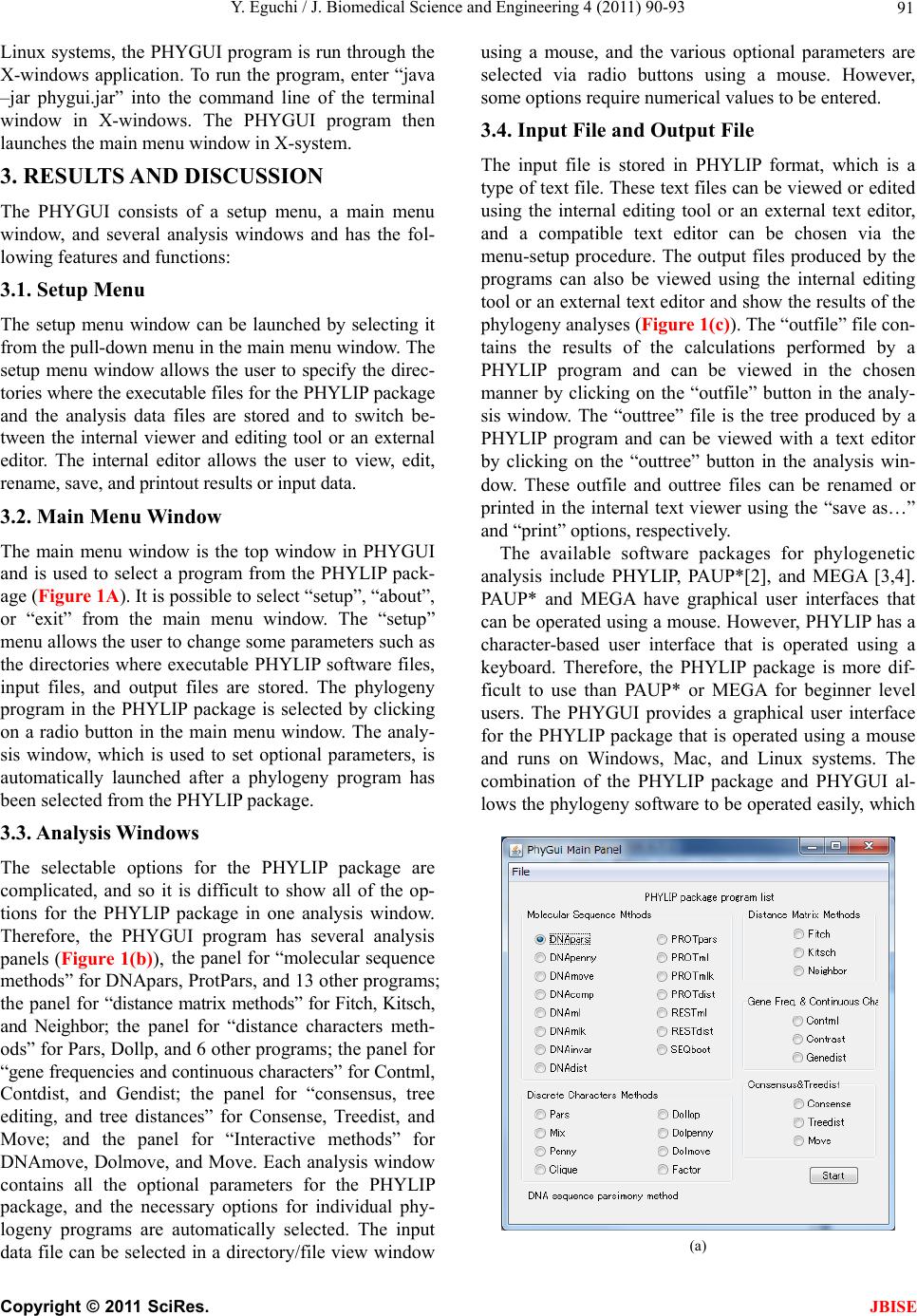
Y. Eguchi / J. Biomedical Science and Engineering 4 (2011) 90-93 91
Linux systems, the PHYGUI prog ram is run through the
X-windows application. To run the program, enter “java
–jar phygui.jar” into the command line of the terminal
window in X-windows. The PHYGUI program then
launches the main menu window in X-system.
3. RESULTS AND DISCUSSION
The PHYGUI consists of a setup menu, a main menu
window, and several analysis windows and has the fol-
lowing features and functions:
3.1. Setup Menu
The setup menu window can be launched by selecting it
from the pull-down menu in the main menu window. The
setup menu window allows the user to specify the direc-
tories where the executable files for the PHYLIP package
and the analysis data files are stored and to switch be-
tween the internal viewer and editing tool or an external
editor. The internal editor allows the user to view, edit,
rename, save, and pri ntout results or input data.
3.2. Main Menu Window
The main menu window is the top window in PHYGUI
and is used to select a program from the PHYLIP pack-
age (Figure 1A). It is possible to select “setup”, “about”,
or “exit” from the main menu window. The “setup”
menu allows the user to change some parameters such as
the directories where executable PHYLIP software files,
input files, and output files are stored. The phylogeny
program in the PHYLIP package is selected by clicking
on a radio button in the main menu window. The analy-
sis window, which is used to set optional parameters, is
automatically launched after a phylogeny program has
been selected from the PHYLIP package.
3.3. Analysis Windows
The selectable options for the PHYLIP package are
complicated, and so it is difficult to show all of the op-
tions for the PHYLIP package in one analysis window.
Therefore, the PHYGUI program has several analysis
panels (Figure 1(b)), the panel for “molecular sequence
methods” for DNApars, ProtPars, and 13 other programs;
the panel f or “distance matrix methods” for Fitch, Kitsch,
and Neighbor; the panel for “distance characters meth-
ods” for Pars, Dollp, and 6 other programs; the panel for
“gene frequencies and continuous characters” for Contml,
Contdist, and Gendist; the panel for “consensus, tree
editing, and tree distances” for Consense, Treedist, and
Move; and the panel for “Interactive methods” for
DNAmove, Dolmove, and Move. Each analysis window
contains all the optional parameters for the PHYLIP
package, and the necessary options for individual phy-
logeny programs are automatically selected. The input
data file can be selected in a directory/file view window
using a mouse, and the various optional parameters are
selected via radio buttons using a mouse. However,
some opt i ons require numer i c al values to be en t ered.
3.4. Input File and Output File
The input file is stored in PHYLIP format, which is a
type of text file. These text files can be viewed or edited
using the internal editing tool or an external text editor,
and a compatible text editor can be chosen via the
menu-setup procedure. The output files produced by the
programs can also be viewed using the internal editing
tool or an extern al text editor and show the resu lts of the
phylogeny analyses (Figure 1(c)). The “outfile” f ile co n-
tains the results of the calculations performed by a
PHYLIP program and can be viewed in the chosen
manner by clicking on the “outfile” button in the analy-
sis window. The “outtree” file is the tree produced by a
PHYLIP program and can be viewed with a text editor
by clicking on the “outtree” button in the analysis win-
dow. These outfile and outtree files can be renamed or
printed in the internal text viewer using the “save as…”
and “print” options, respectively.
The available software packages for phylogenetic
analysis include PHYLIP, PAUP*[2], and MEGA [3,4].
PAUP* and MEGA have graphical user interfaces that
can be operated using a mouse. However, PHYLIP has a
character-based user interface that is operated using a
keyboard. Therefore, the PHYLIP package is more dif-
ficult to use than PAUP* or MEGA for beginner level
users. The PHYGUI provides a graphical user interface
for the PHYLIP package that is operated using a mouse
and runs on Windows, Mac, and Linux systems. The
combination of the PHYLIP package and PHYGUI al-
lows the phylogen y software to be operated easily, which
(a)
C
opyright © 2011 SciRes. JBISE